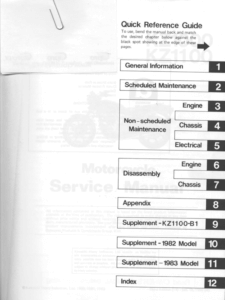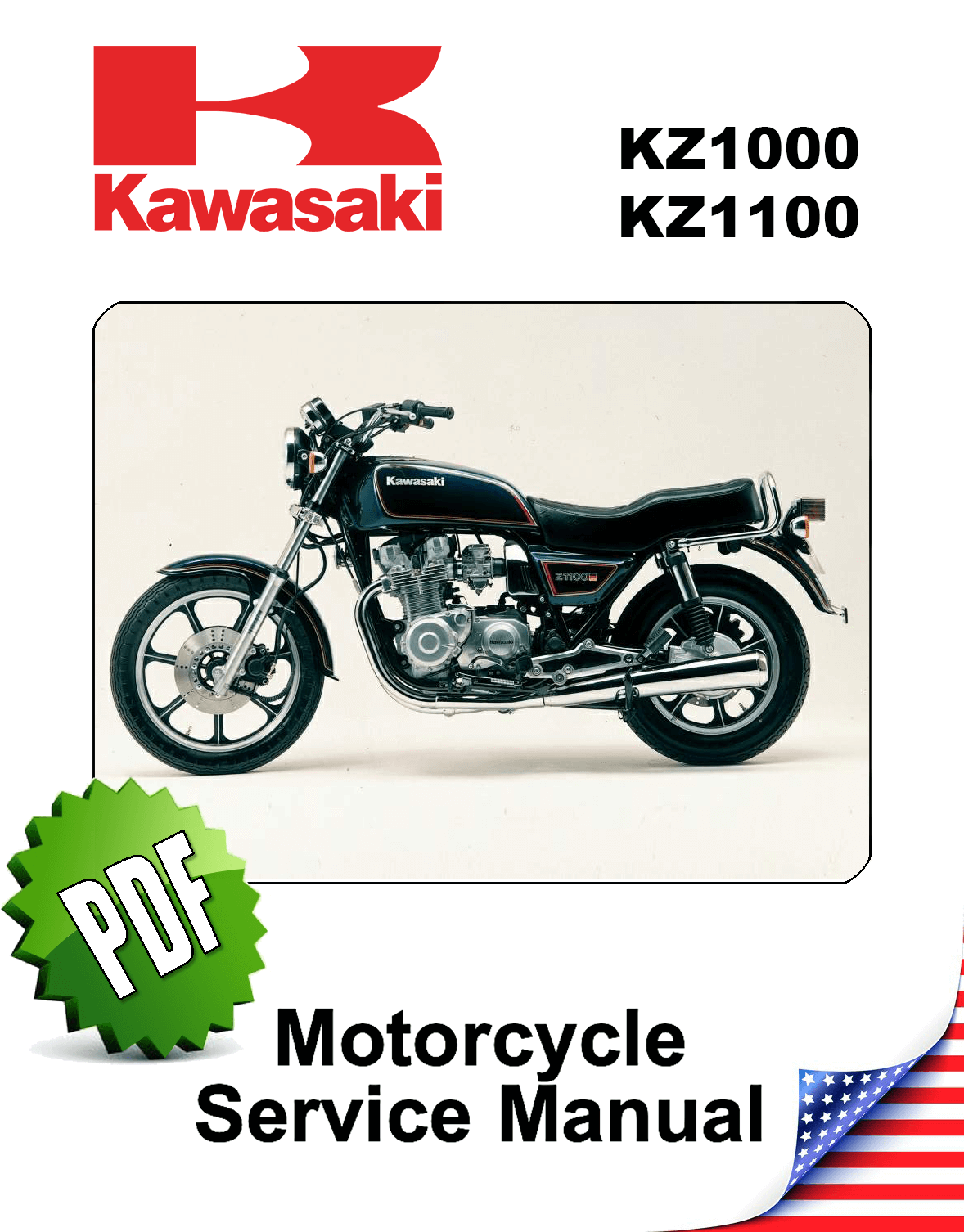Complete PDF version of the Service Manual for the Kawasaki KZ1000/1100. A MUST for every KZ1000 owner.
Download: Immediately after payment!
OEM Original factory workshop manual.
Models covered by this manual: 1981 to 1984
Number of pages: 370 pages
Table of contents:

This PDF repair manual can be downloaded right after the payment process in complete, on the device of your choice.
We do not offer printed manuals, for the following reasons:
- it is more eco-friendly to use a digital version
- your manual never gets dirty or greasy
- you can always choose to print the specific page(s) you need to work on your bike
- you receive your manual immediately after payment
- it is searchable

Kawasaki KZ1000
The Kawasaki Kz1000 or Z1000 is a motorcycle manufactured by Kawasaki in Japan. Production began in September 1976 for the 1977 model year. The Z1000A1 was an updated model that succeeded the 1976 Kawasaki KZ900 (Z900), which in turn replaced the Z1 in the Z series, which debuted in 1972. It sports a four-cylinder inline engine and a five-speed gearbox with a ‘one down and four up’ ratio. It was one of the quickest production bikes of the time, with around 90 horsepower. The police model was manufactured until 2005.
Models
The KZ900 and KZ1000 differ significantly in that the 1000 has a stronger crankshaft for reduced engine vibration, smoother acceleration, and a greater displacement as a result of extending the cylinder size from 66mm to 70mm. The rear disc brake was added to the 1000. There were many specifications and assembly configurations available, such as choosing between chain-drive and shaft-drive. The LTD cruiser was built in Nebraska and marketed in the United States and Canada.
On the LTD, Kawasaki replaced the classic 4-4 exhaust (available on the Z1 and KZ900) with a 4-2 Jardine exhaust (standard on the KZ900B) and a quiet and restrictive muffler on the 1000 A1 and A2. In 1979 and 1980, the KZ1000 was available with either a chain drive or a shaft drive, denoted by the letters ST and SHAFT, as well as the models KZ1000E1 and E2. The KZ1000’s frame was a traditional featherbed (duplex cradle) design that had not been considerably modified in over 30 years of manufacture in terms of fundamental geometry. Frame structure was altered with the introduction of larger frame tubes in the MkII versions (1979/80) to enhance frame stiffness.
The 1980 Kawasaki Z1000H was the world’s first mass-produced fuel-injected motorcycle, as well as Kawasaki’s first. It was built on the chassis and bodywork of the KZ1000A3/A4 Mk.II, but with a distinctive black/gold/white color scheme with gold mag wheels. The Z1000H was limited to 1000 units for the global market. The Z1000H was only produced for three months, in March/April/May 1980, and served as a test bed for the upcoming new 1981 fuel-injected variant, the GPz1100B1.In the United States, the Z1000G “Z-1 Classic,” which was based on the LTD chassis and bodywork, had the same fuel injection technology as the Z1000H.
The 1981 Kawasaki Z1000J debuted with Kawasaki’s new “J” engine, which had a displacement of 998 cc (60.9 cu in). The displacement was reduced from 1015cc to 998cc to comply with the new superbike racing rule, which specified a maximum displacement of 1000cc.
Kawasaki released the KZ1000R1 Eddie Lawson Replica (ELR) for the 1982 model year, based on the KZ1000J2. The 1983 variant, known as the KZ1000R2, was equipped with cams and a cylinder head from the 1982 GPz1100B2, which increased power from 102 to 104 at 8500 rpm. The bike was restricted to 750 units and was named after Eddie Lawson’s 1981-1982 Superbike. It featured a stated 59 kW (79 hp) rear wheel HP @ 8,500rpm and a dry weight of 246.5 kg (543.5 lb).
Aside from the 1982-2005 KZ1000P Police motorbike, the model was phased out in 1984 in favor of Kawasaki’s liquid-cooled Ninja GPZ900R.
Source: Wikipedia

